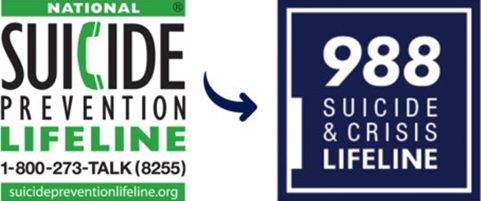
Find Help in a Crisis
What is a crisis situation?
A “crisis” situation is happening if a person with mental illness is:
- A danger to themselves
- If other people are in danger
- If their symptoms are escalating and their behavior is becoming out of control or dangerous
How should a crisis be handled?
When a crisis occurs, it is usually not expected. It is important to be prepared for the unexpected; to have a plan in place. Create a list of important phone numbers and information. Keep it somewhere accessible, next to the phone, in your wallet, etc. Include the following information:
- Your local crisis services phone number and local ER phone number
- The name and phone number of the person’s psychiatrist and psychologist
- A list of the person’s medications (the names and dosage information)
- The person’s diagnosis and, if possible, treatment history
- The name of a friend or family member that may be of assistance
- The number for the local police department
It is helpful to speak to a local mental health worker ahead of time, so if services are needed you know what to expect and how to obtain them.
What services will crisis provide and how do crisis services “work”?
In emergencies, local law enforcement agencies may also play an important role in obtaining mental health care. In the event of a crisis, crisis services may send an individual to evaluate the situation. That person is usually trained to conduct an evaluation for presence of serious mental illness and assess the level of dangerousness, if any. Often if the crisis worker comes to a private home or apartment to conduct an evaluation, they will bring a police officer with them for their own safety, and for the safety and protection of other people at the crisis scene. Normally the police officer is not present to arrest the ill person unless an illegal act has been committed. However, law enforcement procedures commonly require police officers to transport the mentally ill person in a police cruiser to a hospital.
Plan Ahead: If you sense a deterioration in your friend or relative’s mental condition, contact their doctor, case manager, or social worker. If it should become necessary to call the crisis emergency telephone number or the police, have written information available about the ill person’s diagnosis, medications, and specific behavior that precipitated the crisis. It may be useful to have several copies to give to the crisis intervention workers and the ER workers.
New Vista Emergency Services
Many Suicides are Preventable
Suicide is a serious public health problem. In the United States, it is the eighth leading cause of death overall and the third leading cause of death for young people aged 15–24. More than 30,000 people take their own lives every year. For every death by suicide, there are about 20 suicide attempts.
Nearly everyone sometime in their life thinks about suicide. Most people decide to live because they eventually come to realize the crisis is temporary and death isn’t. It is not unusual, however, for someone in a crisis to perceive “no way out” of their dilemma and feel an utter loss of control. When one can’t cope and can’t see how things are ever going to get any better, desperation grows.
Suicidal thoughts and behavior can be successfully treated and often can be avoided if help is obtained soon enough. Recognizing when someone might be suicidal and getting the person help are what’s crucial.
What to do When You Suspect Someone is Suicidal
Some people believe, “If people are determined to kill themselves, nothing is going to stop them.” This is not true. Again, most suicidal people don’t want to die; they want to stop the pain. The impulse to end it all, however overpowering, does not last forever. And proper treatment can eliminate suicidal symptoms. If you suspect someone is suicidal, the first and most important step is to engage that person, to connect with that person. They may have already “signed off” from the world. Your job is to reestablish communications. Talking helps ease the pain. Try to gage the gravity of the situation. Some people believe that “talking about suicide may give someone the idea.” This is not true.
You don’t give a suicidal person morbid ideas by talking about suicide. Bringing up the subject and discussing it openly can give the person a great sense of relief. They don’t have to keep it a secret any longer, and this allows them to open up about the underlying issues. Treat all feelings, gestures, and language seriously. Be non-judgmental. Accept the person’s feelings and don’t try to talk them out of those feelings.
- Don’t debate whether suicide is right or wrong, or feelings are good or bad.
- Don’t lecture on the value of life.
- Don’t give advice by making decisions for the person or telling them to behave differently.
- Don’t dare them to do it. Share your feelings of concern for the person. Offer hope that alternatives are available but do not offer glib reassurances or try to make light of the situation. It only proves you don’t understand. Offer empathy, not sympathy.
- Do not make a promise of secrecy. Saving a life takes precedence over confidentiality and loyalty. Ask who else knows.
- Do not ask if the person wants help but tell them you will help.
- Do not allow a rejection of help. Once you have connected with the person, do not leave them. You are their bridge back to life. Make it clear you will stick with them until they are connected with someone who can really help them. Encourage an anti-suicide pact.
- Get a commitment not to attempt suicide, even if it’s short term.
Take action. Remove means. Get help from persons or agencies specializing in crisis prevention and suicide prevention. Get immediate help for the person if they are really at risk of hurting themselves by calling 911. Finally, get help for yourself. Taking care of someone who is hurting and it can take its toll on you. Consider talking to a professional about the experience after it is over.
HOW TO GET HELP:
There is a wide range of treatment available for suicidal behavior, including medications and “talk” therapies. The key is to get the person professional help as soon as possible. It is better to recognize a potential danger and have it addressed at an outpatient clinic than to wait until the only option is the Emergency Room.
If you know someone who has some of the risk factors above, a first step would be to find out whether the person has a “safety net” — a caseworker or a school psychologist, for example. Many times, there are professionals who are already involved with the person. If not, then it is a matter of finding the right professionals and getting them involved.
The next step would be to contact these professionals and share your concerns. When speaking to professionals, remember that they might be limited by confidentiality rules in what they can tell you about the person, but they can and should listen to everything that you have to tell them. If you notice some warning signs, it is imperative to get the word out to as many people who can help as possible: not only to a mental health professional, but to anyone who can help: family, friends, teacher, doctor, clergy. Find the people the person will respond to and sound the alarm. Figure out the best way to intervene to get the person professional help and then do it. If you are dealing with someone who is in crisis, call your local crisis line. If there is immediate danger, call 911.
National Helplines:
- New Vista Crisis Line 24-Hour Helpline at 1.800.928.8000
- National Suicide Prevention Lifeline: 1–800-SUICIDE (784‑2433)
- Crisis Text Line Text HOME to 741741 to connect with a Crisis Counselor
- SAMHSA 1–800-662-HELP (4357)
- The Trevor Project: 1–800-850‑8078 (for gay or questioning youth)
- Veterans Crisis Line Call 1–800-273‑8255 and Press 1 Text 838255
- National Sexual Assault Hotline 1–800-656-HOPE (4673)
- National Teen Dating Abuse Helpline 1–866-331‑9474
Finally, despite your best efforts someone may go on to complete suicide. Their pain and wish to escape may be too overwhelming. They is responsible for their death, not you. Seek support and counseling.
What are the Warning Signs?
These indicators help one to recognize the threat of suicide in others. While it is possible to misinterpret any one of these signs, putting them together with other indicators, such as the risk factors above, should show that action must be taken. When the signs are there, it is time to act. The danger of embarrassment through overreaction is not nearly as great as the danger of death through failure to act.
A suicide threat or other statement indicating a desire or intention to die. Some people believe that “people who talk about suicide won’t really do it.” This is not true. Almost everyone who commits suicide has given some clue or warning. Do not ignore suicide threats. Statements like “You’ll be sorry when I’m dead,” or “I can’t see any way out” — no matter how casually or jokingly said — may indicate serious suicidal feelings.
Change in personality or behavior: The changes generally are sudden and quite noticeable. The person who has been reserved or conservative suddenly becomes loud and conspicuous. The person who was outgoing and friendly becomes aloof and wants to be alone. The one who is usually happy is sad, sees their options slipping away. The one who is usually depressed can be much happier; they see a “light at the end of the tunnel.” Unusually aggressive, destructive or defiant behavior; a lack of concentration on school, work or routine tasks; a change in sleep patterns, eating habits, and a loss of interest in activities the person previously enjoyed are all “red flags” that something might be very wrong.
Making arrangements as though for a final departure: Preparations before suicide vary with the person’s personality or circumstances. They often consist of what is generally referred to as “getting one’s affairs in order.” To the head of the household this might mean preparing a will or reviewing insurance papers. To a housewife it might mean writing long overdue letters or patching up bad feelings with relatives or neighbors. To a teenager, it might mean giving away personal possessions with sentimental value – jewelry, skis, CDs. Final preparations may be made very quickly, with the suicide following abruptly. Prevention often relies on detection of the earlier signs, such as comments about death, depression and marked personality changes.
Hopelessness: A critical warning sign is when a person’s thinking gets so constricted, they only see things as “black or white” and their life as all black with no patches of gray. “This is the way it is,” they think. “It will never get better.”
Other warning signs:
- Increased drug or alcohol use.
- Taking unnecessary risks/careless behavior/accidents.
- Feelings of overwhelming guilt, shame or self-hatred.
- Fear of losing control, “going crazy,” harming self or others.
- Worry about money or illness (real or imaginary).
- Preoccupation with death and dying.
- Loss of interest in personal appearance
Who Could Be In Danger? (Risk Factors)
There is no typical suicide victim. It happens to young and old, rich and poor. There are some common “risk factors,” however. While many people experience one or more of these risk factors and do not contemplate suicide, they are useful in identifying someone who might become suicidal.
Some people believe that “People who commit suicide are people who were unwilling to seek help.” This is not true. For example, studies of suicide victims have shown that more than half had sought medical help within six months before their deaths. That is why the Surgeon General’s Office recommends training physicians in suicide risk assessment, and also teachers and school personnel, clergy, police officers, correctional personnel and emergency health care personnel as well. The opportunities are there to spot and prevent potential suicides before they reach the crisis stage, if one knows what to look for:
A diagnosable mental health problem or alcohol or drug problem: Suicidal thoughts and behavior can be symptoms of a mental illness or substance abuse disorder. Most often they are symptoms of moderate to severe depression. Depression is a medical condition that is often accompanied by a loss of appetite; sleep disturbances, general bodily complaints, social isolation/withdrawal and a lack of interest in or enjoyment of everyday living as well as feelings of loneliness, worthlessness, guilt and sadness. Depression can also be a consequence of a person’s struggle to overcome a serious mental health or substance abuse problem and the stigma of having such problems. Dealing with any debilitating illness can be depressing but having a “socially unacceptable” illness creates added pressures. Accidental suicides are sometimes caused by delusions and often by drug overdoses. People who have undergone drug rehab and go back to using often overdose because they think their bodies can still tolerate the quantity of drugs they used to take. Many times, people have both mental health and substance abuse problems that “feed” each other. Both need to be treated at the same time for the person to get better.
Adverse life events, especially significant losses: The significance of the loss is always subjective. It could be anything from the loss of a best friend to failure to get an “A” on an exam. It is whether the person can cope with the loss that is important.
Impulsiveness: Even the most severely depressed person has mixed feelings about death, wavering until the very last moment between wanting to live and wanting to die. Most suicidal people do not want to die; they want the pain to stop. While the decision to kill oneself may be reached over a long period of time, going through with it often requires “seizing the moment.” Impulsive people, or people rendered impulsive by alcohol or drugs, are most likely to find themselves “taking the plunge.”
Previous suicide attempt: To be determined to kill oneself takes a lot of “psychic energy” which can be sustained for only a limited period of time, usually no more than two to three days. However, many suicides occur within about three months following the beginning of “improvement” after a suicidal crisis, when the person has regained the energy to try again.
Other Risk Factors:
- Family violence, including physical or sexual abuse
- Feelings of rage
- Family history of suicide
- Family history of mental health or substance abuse problem
- Incarceration
- Exposure to the suicidal behavior of others, including family, peers or through the media.












